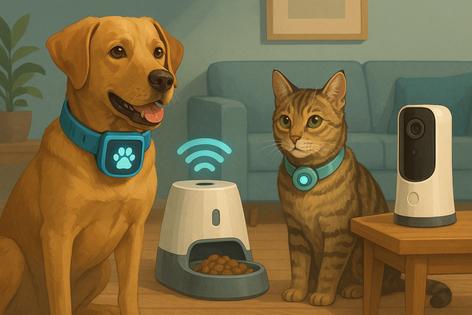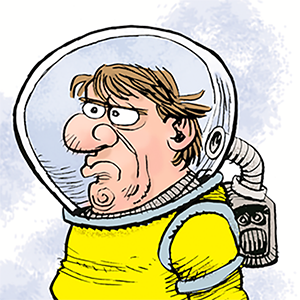The Rise of Pet Tech
Published in Cats & Dogs News
Once limited to chew toys and kibble brands, the pet industry has undergone a technological revolution. Smart devices, tracking apps, and even artificial intelligence are transforming how people interact with their cats and dogs. For many owners, the gadgets once seen as novelties are becoming essential tools in modern pet care.
Collars That Think
Smart collars, once marketed only for hunting dogs, now resemble sleek fitness trackers. Many models monitor steps, sleep cycles, and even heart rate. Some combine GPS with geofencing, alerting owners if a dog strays too far or a cat wanders beyond the backyard.
Companies such as Fi and Whistle have cultivated a loyal user base by emphasizing peace of mind. “It’s less about knowing where your dog is every second and more about catching subtle changes in health,” said Dr. Lauren Carr, a veterinarian who encourages wearables for senior pets.
Feeding With Algorithms
Automated feeders have advanced far beyond a plastic bowl with a timer. Today’s devices sync to smartphones, dispense portion-controlled meals, and even recognize individual pets through microchips or collar tags.
Cats in multi-pet households benefit especially, since technology can prevent food theft by a more aggressive animal. Some models now track nutritional intake over weeks, alerting owners if a pet skips meals or eats less—a potential early warning sign of illness.
Cameras, Companionship, and Remote Treats
Pet cameras have become a booming category. Far from simple baby monitors, these devices allow two-way communication, video recording, and even treat dispensing with the push of an app button.
For dog owners managing separation anxiety, the ability to speak to a pet remotely—or launch a snack across the living room—provides comfort on both ends of the leash. Cats, true to form, often appear indifferent, but camera companies report plenty of felines captivated by laser-pointer features built into their devices.
Artificial Intelligence Joins the Pack
The latest frontier is AI-driven behavior analysis. Startups are developing apps that claim to interpret barks or meows into basic emotional states such as “hungry,” “lonely,” or “in pain.” While the science is still maturing, the promise of decoding animal communication has generated significant buzz.
AI is also helping veterinarians. Cloud-based platforms analyze X-rays or lab results faster than human technicians, supporting quicker diagnoses. In shelters, AI-assisted adoption platforms match dogs and cats with prospective owners based on lifestyle data, improving placement rates.
Health Data at Home
Wearables and sensors increasingly overlap with medical care. Litter boxes equipped with moisture and weight sensors now deliver data on urination patterns—vital for detecting kidney issues in cats. Similar devices for dogs track gait and posture, identifying early signs of arthritis.
“Preventive health is where pet tech shines,” said Dr. Jamal Ortiz, a veterinary internist. “By the time a limp is obvious, disease may already be advanced. Sensors help us intervene sooner.”
The Ethical Debate
Not everyone embraces the shift. Critics question whether constant surveillance undermines pets’ independence, or if relying too heavily on gadgets could erode traditional care practices. There is also the issue of data: some companies store detailed pet health and location information, raising privacy concerns.
Animal behaviorists caution that technology should complement, not replace, human attention. “A treat-dispensing camera is fun, but it doesn’t substitute for a daily walk or real companionship,” said trainer Emily Vargas.
A Growing Market
Numbers suggest pet tech is more than a fad. The American Pet Products Association estimates that the global market for smart pet devices surpassed $5 billion last year, with projections to double within five years. Investment firms are pouring resources into startups promising breakthroughs in biometric collars and AI interpretation tools.
Retailers are also adjusting. Major chains dedicate entire aisles to high-tech gear, while online marketplaces feature hundreds of specialized accessories. From self-cleaning litter boxes to climate-controlled dog houses, the range of options has expanded dramatically.
What’s Next
Future developments may push the boundaries of imagination. Researchers are experimenting with wearable translation devices that might detect patterns in body posture or vocalization more accurately than current apps. Veterinary telemedicine platforms could merge with home monitoring tools, allowing vets to assess a patient’s data in real time.
And as human health increasingly relies on digital assistants and wearables, pets are likely to follow suit. The question isn’t whether technology will shape pet care, but how far owners—and their animals—are willing to go.
A Digital Leash on the Future
For many, the appeal of pet tech boils down to reassurance. A blinking collar light on a late-night walk, an app notification that a senior dog slept well, a camera feed of a cat sprawled on the couch—all serve as modern comfort.
The devices may be digital, but the goal is timeless: to strengthen the bond between humans and the animals who share their homes.
========
This article was written, in part, utilizing AI tools.









Comments